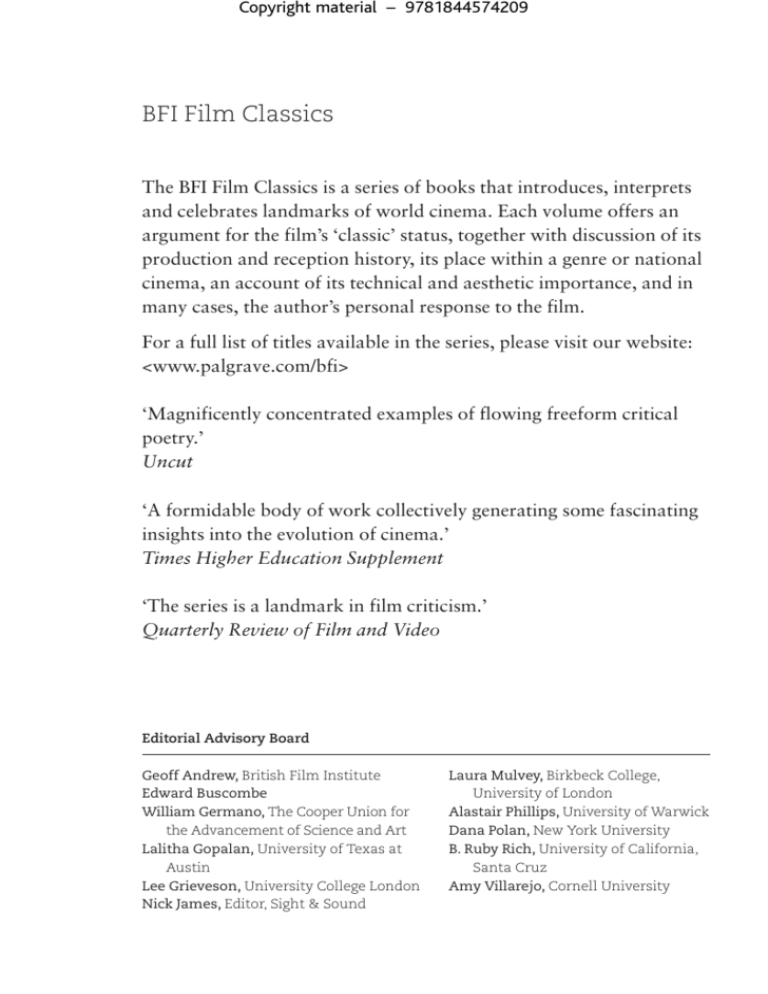
Copyright material – 9781844574209
BFI Film Classics
The BFI Film Classics is a series of books that introduces, interprets
and celebrates landmarks of world cinema. Each volume offers an
argument for the film’s ‘classic’ status, together with discussion of its
production and reception history, its place within a genre or national
cinema, an account of its technical and aesthetic importance, and in
many cases, the author’s personal response to the film.
For a full list of titles available in the series, please visit our website:
<www.palgrave.com/bfi>
‘Magnificently concentrated examples of flowing freeform critical
poetry.’
Uncut
‘A formidable body of work collectively generating some fascinating
insights into the evolution of cinema.’
Times Higher Education Supplement
‘The series is a landmark in film criticism.’
Quarterly Review of Film and Video
Editorial Advisory Board
Geoff Andrew, British Film Institute
Edward Buscombe
William Germano, The Cooper Union for
the Advancement of Science and Art
Lalitha Gopalan, University of Texas at
Austin
Lee Grieveson, University College London
Nick James, Editor, Sight & Sound
Laura Mulvey, Birkbeck College,
University of London
Alastair Phillips, University of Warwick
Dana Polan, New York University
B. Ruby Rich, University of California,
Santa Cruz
Amy Villarejo, Cornell University
Copyright material – 9781844574209
Copyright material – 9781844574209
Written on the Wind
Peter William Evans
A BFI book published by Palgrave Macmillan
Copyright material – 9781844574209
For Isabel
© Peter William Evans 2013
All rights reserved. No reproduction, copy or transmission of this publication may be made
without written permission. No portion of this publication may be reproduced, copied or
transmitted save with written permission or in accordance with the provisions of the Copyright,
Designs and Patents Act 1988, or under the terms of any licence permitting limited copying
issued by the Copyright Licensing Agency, Saffron House, 6–10 Kirby Street, London EC1N 8TS.
Any person who does any unauthorised act in relation to this publication may be liable to
criminal prosecution and civil claims for damages.
The author has asserted his right to be identified as the author of this work in accordance
with the Copyright, Designs and Patents Act 1988.
First published in 2013 by
PALGRAVE MACMILLAN
on behalf of the
BRITISH FILM INSTITUTE
21 Stephen Street, London W1T 1LN
www.bfi.org.uk
There’s more to discover about film and television through the BFI. Our world-renowned archive,
cinemas, festivals, films, publications and learning resources are here to inspire you.
Palgrave Macmillan in the UK is an imprint of Macmillan Publishers Limited, registered in
England, company number 785998, of Houndmills, Basingstoke, Hampshire RG21 6XS.
Palgrave Macmillan in the US is a division of St Martin’s Press LLC, 175 Fifth Avenue, New York,
NY 10010. Palgrave Macmillan is the global academic imprint of the above companies and has
companies and representatives throughout the world. Palgrave® and Macmillan® are registered
trademarks in the United States, the United Kingdom, Europe and other countries.
Series cover design: Ashley Western
Series text design: ketchup/SE14
Images from Written on the Wind, © Universal Pictures Company, Inc.
Set by Cambrian Typesetters, Camberley, Surrey
Printed in China
This book is printed on paper suitable for recycling and made from fully managed and sustained
forest sources. Logging, pulping and manufacturing processes are expected to conform to the
environmental regulations of the country of origin.
British Library Cataloguing-in-Publication Data
A catalogue record for this book is available from the British Library
A catalog record for this book is available from the Library of Congress
10 9 8 7 6 5 4 3 2 1
22 21 20 19 18 17 16 15 14 13
ISBN 978–1–84457–420–9
Copyright material – 9781844574209
Contents
Acknowledgments
6
Overture: The Wind
7
1 Production and Promotion
14
2 Realism, Modernism and Melodrama
23
3 Mise en scène
29
4 Dorothy Malone/Marylee: ‘Enough devil in her …’
50
5 Lauren Bacall/Lucy: ‘A lady, a beautiful lady’
62
6 Rock Hudson and Robert Stack: Cain and Abel
79
Coda: The River
90
Synopsis
94
Notes
95
Credits
96
Bibliography
98
Copyright material – 9781844574209
6
BFI FILM CLASSICS
Acknowledgments
I am grateful to Rebecca Barden and the BFI Film Classics board for
supporting the inclusion of this volume in the series. My thanks are
also due to the anonymous BFI Classics readers for their helpful
comments on an earlier draft, Sophia Contento at BFI Publishing, the
British Academy for a grant enabling me to research archives in Los
Angeles, Laura Mulvey for her encouragement and for refereeing my
BA grant application, Jon Halliday for helpful comments and
suggestions, the Margaret Herrick Library of the Academy of Motion
Picture Arts and Sciences (especially Barbara Hall), as well as the
UCLA (especially Lauren Buisson) and USC (especially Ned
Comstock) libraries, where I carried out most of the research for this
volume. I also consulted material at the Queen Mary, University of
London Library, the British Library, the British Film Institute Library,
the University of Roehampton Library and the University of London
Senate House Library. I am grateful and indebted to my colleagues in
the Department of Film Studies, in the School of Languages,
Linguistics and Film, Queen Mary, University of London, as well as,
more generally in the School, to Jill Evans and Rüdiger Goerner.
Katie-Jane Hext, Ron Guariento, Andrea Sabbadini, Christopher
Cordess, Carine Ronsmans, the Fulham film club, Prue Downing,
Louise Riley-Smith, Philippa Hudson, Marta Rey and Carlos
Troncoso also helped and encouraged me in various ways.
Bruce Babington, my friend and collaborator over many years, and
co-author of our publications that began with a 1990 Movie article
on Sirk, ran his expert eye over an early draft and made many useful
suggestions. Isabel, Tom, Jenni, Phil, Tabitha, Michael and family
were a source of much-needed encouragement during the later stages
of the writing of this book. Isabel’s insights and suggestions have
been, as ever, indispensable. This book is dedicated to her.
Copyright material – 9781844574209
WRITTEN ON THE WIND
Overture: The Wind
As a yellow 1953 Allard J2X hot rod driven by Kyle Hadley (Robert
Stack) scorches through a Texan Monument Valley of derricks and
telegraph poles, heading towards Hadley, an oil town, Frank
Skinner’s portentous music, carried initially by predominantly brass
instruments, warns of impending catastrophe, the ‘melos’ in the
drama, in Charles Rosen’s words, ‘shaping our perceptions of a
narrative’ (Rosen 2011: 11).
Even before the medium shot of the reckless driver’s swig at a
bottle of ‘raw corn’, the seventh in a montage of eight shots showing
the car racing past from left to right, the doom-laden orchestral score
followed by a song composed specially for the film bind together a
dazzling sequence of sights and sounds to announce the film’s themes.
Sirk’s brilliant matching of the vitality of form and morbidity of
theme introduces his survey of a desperate class through a burst of
furious cinematic energy unparalleled elsewhere in his work.
Racing through a hellish landscape
7
Copyright material – 9781844574209
8
BFI FILM CLASSICS
Eventually, the driver halts his roadster at the entrance of the
antebellum mansion (hired for exteriors by the studio from the
gambling and uranium holdings millionaire, Samuel Kingston).
The rapid but cheerless tempo of the opening bars yields to the
slower, lilting melodic cadences and elegiac lyrics of the Victor
Young–Sammy Cahn tune sung by the Four Aces, accompanying the
credits and preparing the way for its first line, ‘A faithless lover’s
Symbols of the ‘power elite’; Kyle driven by inner furies
Copyright material – 9781844574209
WRITTEN ON THE WIND
kiss’, delivered against the visual backdrop of a window frame,
seen from outside the building.
To the right, in the foreground, stands a dark-suited Mitch
Wayne (Rock Hudson), his eyes staring pensively out of the frame
and into the darkness beyond. The bottom left of the frame shows
Lucy Moore/Hadley (Lauren Bacall), lying in bed, dressed in a
cream-coloured negligee.
The words, ‘A faithless lover’s kiss’, refer to infidelity, but the
visual imagery is ambiguous: a woman – faithless or faithful? – moves
to occupy centre frame. Whether, alternatively, the man looking out of
her bedroom window is innocent or guilty of infidelity is also at this
stage an open question. Played by Rock Hudson, already a Hollywood
hero, whose name now appears on the screen, Mitch, unlike Lucy, and
significantly wearing day clothes, seems an implausible betrayer, though
later revelations confirm guilt of thought, even if not of word and deed.
The camera’s position outside the window distances the viewer from the
characters, and seems to frame them together in a world of airless
hedonism, sheltered from nature’s windblown domain outside.
The next verse, ‘Is written on the wind’, guides the viewer to a
low-angle shot of the hot rod that comes to an abrupt halt in the
Mitch still framed by the Hadleys
9
Copyright material – 9781844574209
10
BFI FILM CLASSICS
driveway, its offside headlamp, prominent in the frame, a giant eye
serving as another of the film’s many lenses that peer into private and
public worlds. Sirk’s (1897–1987) pre-Hollywood modernist heritage
shines through here. The Surrealist tendency to stress the processes of
perception (e.g. the assault on the eye in Un Chien andalou, 1928,
or the eye-obsessed paintings of Dalí and Magritte) finds its more
measured visual complements in these and later scenes. Here, Mitch’s
troubled gaze out of the window, as if projecting his repudiation of the
house and all it represents, mirrors the function of the car’s headlamp,
beaming its slightly skewed probing light onto the audience,
encouraging it to see clearly the complexities of the melodrama ahead.1
The driver alights and approaches the mansion, while the
perspective now shifts to a medium shot of the bedroom interior,
where Lucy attempts vainly to leave her bed, flopping down again,
numbed and unable to face the brewing tragedy. Even when she does
manage it, at the end of the scene, she collapses, as if swathed in what
looks like a winding sheet, the billowing curtain of her luxurious
morgue-like bedroom. Accompanying the words ‘A night of stolen
bliss’ in the score, Lauren Bacall’s name appears, given the same size
lettering as Hudson’s, and in line with her agent’s demands:
Kyle’s roadster as dual symbol of petro-dollar luxury and perception








